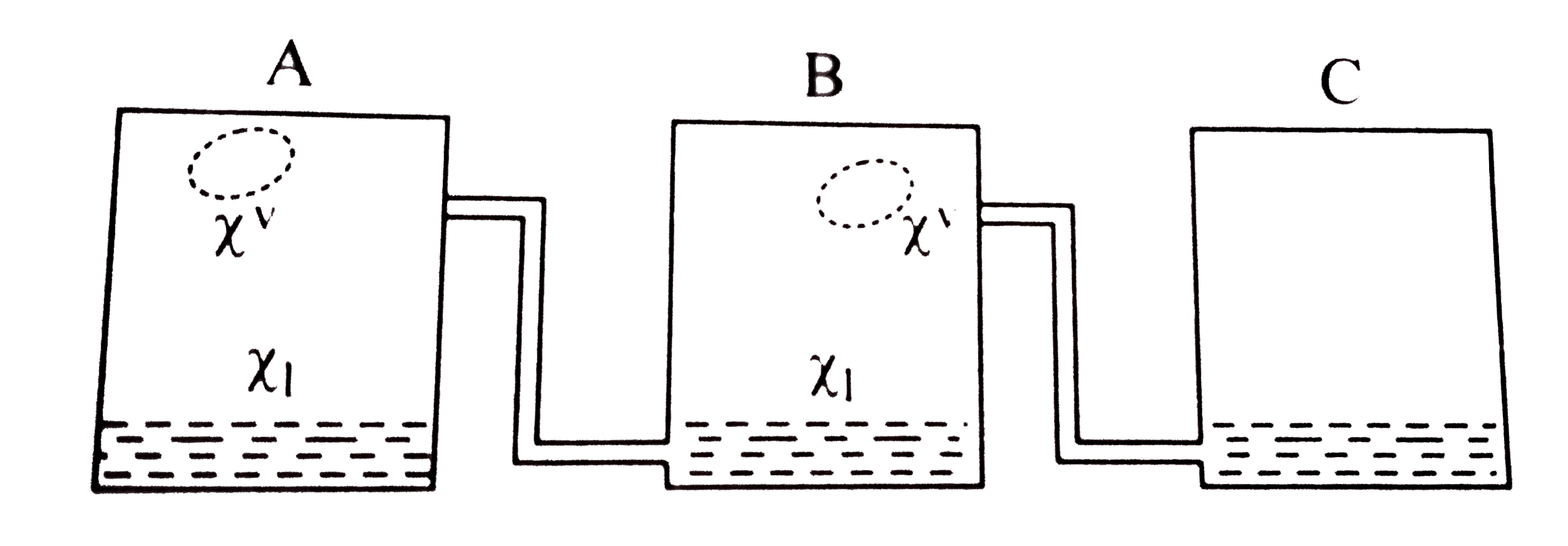Liquids A and B form an ideal mixture, in which the mole fraction of A is 0.25. At temperature T, a small quantity of the vapour in equilibrium with the liquid is collected and condensed. This process is repeated for a second time with first condensate. The second condensate now contains 0.645 mole fraction of A. Calculate the ratio (P∘A/P∘B). What will be the mole fraction of B in the third condensate?
To solve the problem step by step, we will follow the outlined approach based on the information given:
Step 1: Define the mole fractions
Given that the mole fraction of liquid A, xA, is 0.25, we can find the mole fraction of liquid B, xB:
xB=1−xA=1−0.25=0.75
Step 2: Calculate the total pressure
For an ideal solution, the total vapor pressure Ptotal can be expressed as:
Ptotal=P0A⋅xA+P0B⋅xB
Substituting the values:
Ptotal=P0A⋅0.25+P0B⋅0.75
Step 3: Calculate the partial pressures
The partial pressure of A in the vapor phase, PA, is given by:
PA=P0A⋅xA=P0A⋅0.25
The partial pressure of B in the vapor phase, PB, is:
PB=P0B⋅xB=P0B⋅0.75
Step 4: Calculate the mole fraction of A in the vapor phase
The mole fraction of A in the vapor phase, yA, is given by:
yA=PAPtotal=P0A⋅0.25P0A⋅0.25+P0B⋅0.75
Step 5: Set up the equation for the second condensate
After the first condensation, the mole fraction of A in the second condensate is given as 0.645. Thus, we can write:
0.645=P0A⋅0.252P0A⋅0.252+P0B⋅0.752
Step 6: Rearranging the equation
From the equation above, we can rearrange it to find the ratio P0AP0B:
0.645(P0A⋅0.252+P0B⋅0.752)=P0A⋅0.252
This leads to:
0.645P0B⋅0.752=P0A⋅(0.252−0.645⋅0.252)
Step 7: Solve for the ratio P0AP0B
From the above equation, we can isolate P0AP0B:
P0AP0B=0.645⋅0.7520.252−0.645⋅0.252
Calculating the values:
P0AP0B=0.645⋅0.56250.0625−0.645⋅0.0625
This simplifies to:
P0AP0B=0.36281250.0625(1−0.645)=0.36281250.0625⋅0.355
Calculating this gives:
P0AP0B≈2.33
Step 8: Calculate the mole fraction of B in the third condensate
The mole fraction of B in the third condensate can be calculated using:
x(3)B=1−y(3)A
Where y(3)A can be calculated similarly as:
y(3)A=P0A⋅(0.252)2P0A⋅(0.252)2+P0B⋅(0.752)2
Substituting the values will give us the mole fraction of B in the third condensate.
Final Answers:
1. The ratio P0AP0B is approximately 2.33.
2. The mole fraction of B in the third condensate can be calculated from the above steps.
Given that the mole fraction of liquid A, xA, is 0.25, we can find the mole fraction of liquid B, xB:
xB=1−xA=1−0.25=0.75
For an ideal solution, the total vapor pressure Ptotal can be expressed as:
Ptotal=P0A⋅xA+P0B⋅xB
Substituting the values:
Ptotal=P0A⋅0.25+P0B⋅0.75
The partial pressure of A in the vapor phase, PA, is given by:
PA=P0A⋅xA=P0A⋅0.25
The partial pressure of B in the vapor phase, PB, is:
PB=P0B⋅xB=P0B⋅0.75
The mole fraction of A in the vapor phase, yA, is given by:
yA=PAPtotal=P0A⋅0.25P0A⋅0.25+P0B⋅0.75
After the first condensation, the mole fraction of A in the second condensate is given as 0.645. Thus, we can write:
0.645=P0A⋅0.252P0A⋅0.252+P0B⋅0.752
From the equation above, we can rearrange it to find the ratio P0AP0B:
0.645(P0A⋅0.252+P0B⋅0.752)=P0A⋅0.252
This leads to:
0.645P0B⋅0.752=P0A⋅(0.252−0.645⋅0.252)
From the above equation, we can isolate P0AP0B:
P0AP0B=0.645⋅0.7520.252−0.645⋅0.252
Calculating the values:
P0AP0B=0.645⋅0.56250.0625−0.645⋅0.0625
This simplifies to:
P0AP0B=0.36281250.0625(1−0.645)=0.36281250.0625⋅0.355
Calculating this gives:
P0AP0B≈2.33
The mole fraction of B in the third condensate can be calculated using:
x(3)B=1−y(3)A
Where y(3)A can be calculated similarly as:
y(3)A=P0A⋅(0.252)2P0A⋅(0.252)2+P0B⋅(0.752)2
Substituting the values will give us the mole fraction of B in the third condensate.
1. The ratio P0AP0B is approximately 2.33.
2. The mole fraction of B in the third condensate can be calculated from the above steps.
Topper's Solved these Questions
- SOLUTIONSBOOK - CENGAGE CHEMISTRY ENGLISHCHAPTER - SOLUTIONSEXERCISE - Exercises (Linked Comprehension)
58 Videos
- SOLUTIONSBOOK - CENGAGE CHEMISTRY ENGLISHCHAPTER - SOLUTIONSEXERCISE - Exercises (Multiple Correct)
25 Videos
- SOLUTIONSBOOK - CENGAGE CHEMISTRY ENGLISHCHAPTER - SOLUTIONSEXERCISE - Ex 2.3 (Objective)
9 Videos
- SOLID STATEBOOK - CENGAGE CHEMISTRY ENGLISHCHAPTER - SOLID STATEEXERCISE - Ex 1.2 (Objective)
9 Videos
- SURFACE CHEMISTRYBOOK - CENGAGE CHEMISTRY ENGLISHCHAPTER - SURFACE CHEMISTRYEXERCISE - Archives Subjective
2 Videos
Similar Questions
If the mole fraction of Iodine in benzene is 0.25, then what will be the molality of the solution ?
View SolutionWhen vapour condenses into liquid
View SolutionIf Pa and Pb are 108 and 36 torr respectively. What will be the mole fraction of A is vapour phase if B has mole fraction in solution 0.5:
View SolutionLiquids X and Y form an ideal solution. The vapour pressure of X and Y at 100∘C are 300 and 100mm of Hg, respectively. Suppose that a solution composed of 1mol of X and 1mol of Y at 100∘C is collected and condensed. This condensate is then heated at 100∘C and vapour is again condensed to form a liquid A. What is the mole fraction of X in A ?

View SolutionA and B makes an ideal solution. At what mole fraction of A and B, will degree of disorder be maximum with maximum Gibb's energy of mixing ?
View SolutionTwo liquids A and B have P∘AandP∘B in the ratio of 1 : 3 and the ratio of number of moles of A and B in liquid phese are 1 : 3 then mole fraction of 'A' in vapour phase in equilibrium with the solution is equal to :
View SolutionTwo liquids A and B form an ideal solution such that p∘A=700mm and p∘B=300mm. A small amount of solution is vapourized and the vapour condensed (at equilibrium). The condensate has equilibrium vapour pressure of 500mm (at same temperature). Find the composition of the original solution.
View SolutionFor an ideal solution, if a graph is plotted between 1PT and yA (mole fraction of A in vapour phase) where p0A>p0B then
View SolutionIf two substances A and B have p∘A:p∘B=1:2 and have mole fraction in solution as 1:2 then mole fraction of A in vapour phase is
View SolutionAt a certain temperature, the vapour pressure of pure ether is 640mm and that of pure acetone is 280mm. Calculate the mole fraction of each component in the vapour state if the mole fraction of ether in the solution is 0.50.
View Solution
